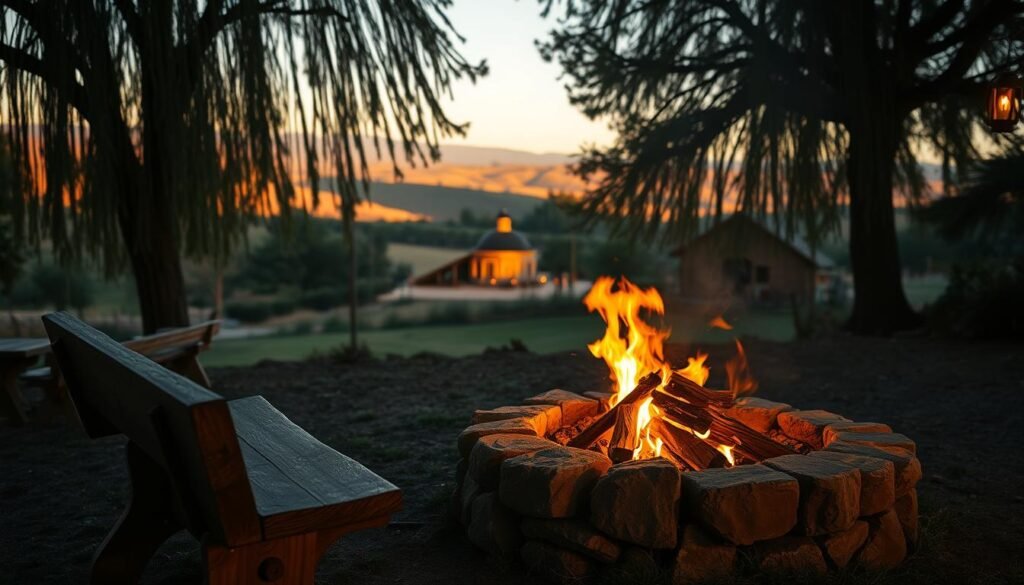Creating a cozy outdoor space often begins with a well-designed fire pit. Whether you’re gathering with friends or enjoying a quiet evening, understanding the basics ensures a safe and enjoyable experience. From selecting the right materials to managing the flames, every detail matters.
Proper wood selection plays a crucial role in maintaining a steady burn. Hardwoods like oak and maple are ideal for longer-lasting flames, while softwoods can help with initial ignition. Tinder, such as dry leaves or small twigs, is essential for getting the fire going. Each step in the process contributes to a successful setup.
Timing is another key factor. Knowing when to add more wood or let the flames die down ensures the fire pit remains under control. Safety measures, like keeping a water bucket nearby, are non-negotiable. This guide will walk you through every aspect, from setup to extinguishing, making it easy for beginners and seasoned users alike.
Key Takeaways
- Choose hardwoods like oak for longer-lasting flames.
- Use tinder such as dry leaves to ignite the fire easily.
- Follow each step carefully for a safe and effective setup.
- Manage timing to control the fire’s intensity.
- Always keep safety tools like a water bucket nearby.
Fire Pit Safety and Initial Preparation
Safety is the cornerstone of any enjoyable fire pit experience. Proper preparation ensures that your outdoor gatherings remain both fun and secure. From selecting the right location to understanding fire behavior, every step matters.
Understanding Fire Safety Guidelines
Fire safety begins with following essential guidelines. Always keep a bucket of water or a fire extinguisher nearby. This helps manage unexpected flare-ups or emergencies. Avoid using gasoline or petroleum-based products, as they can produce toxic fumes and pose explosion risks.
Make sure to check local laws regarding fire pit usage. Regulations vary by region, and compliance ensures you avoid fines or hazards. Supervision is critical—never leave the flames unattended, especially when children or pets are nearby.
Choosing the Right Location and Surface
Selecting a safe location is vital. Place your fire pit at least 10 feet away from structures, trees, or flammable materials. A stable, non-flammable surface, such as stone or gravel, provides a secure base. Avoid grassy or wooden areas that can easily catch fire.
Consider wind conditions when setting up. Strong gusts can spread sparks, increasing the risk of accidental fires. A deeper fire pit design may perform better in windy environments, reducing the chances of flames escaping.
- Keep a bucket of water or fire extinguisher within reach.
- Maintain a safe distance from flammable materials.
- Choose a stable, non-flammable surface for the fire pit.
- Monitor wind conditions to prevent sparks from spreading.
- Supervise the flames at all times to ensure safety.
Gathering Materials and Building Your Fire Structure
Building a successful fire requires the right materials and tools. Quality components ensure efficiency and safety, making the process smoother and more enjoyable. From tinder to firewood, each material plays a vital role in creating a lasting flame.

Selecting the Perfect Tinder, Kindling, and Firewood
Tinder is the foundation of any fire. Dry leaves, small twigs, or newspaper work well to ignite the flames. Ensure your tinder is completely dry for the best results. Kindling, such as slightly larger sticks, helps sustain the fire as it grows.
For firewood, seasoned hardwoods like oak or maple are ideal. They burn longer and produce consistent heat. Avoid green or wet wood, as it creates excess smoke and struggles to ignite. Proper material selection ensures a safe and efficient fire.
Preparing Tools and Equipment for a Successful Fire
Having the right tools makes a significant difference. A reliable fire starter, like matches or a lighter, is essential. Long-handled pokers or sticks help adjust the logs without getting too close to the flames.
Place your tools on the side of the pit for easy access. A bucket of water or a fire extinguisher should always be nearby for emergencies. These preparations ensure you can manage the fire safely and effectively.
- Choose dry tinder and kindling for easy ignition.
- Use seasoned hardwoods for longer-lasting flames.
- Keep tools like pokers and lighters within reach.
- Always have water or a fire extinguisher nearby for safety.
Essential Steps: How to Start a Fire Pit
Mastering the art of a well-built flame begins with proper airflow and structure. A thoughtful layout ensures efficient burning and consistent heat. Follow this guide to create a safe and effective setup.
Constructing the Fire Layout for Optimal Airflow
Airflow is critical for a steady burn. Arrange your materials with enough space for oxygen to circulate. Popular structures include the teepee, cross, and log-cabin layouts.
For a teepee setup, place tinder in the center and lean small twigs around it at a 35-degree angle. This design promotes airflow and helps the flames spread evenly. Ensure a safe distance between the structure and the pit’s edges.
Lighting Techniques and Best Practices
To get fire started, light the tinder from multiple sides. Use a long match or lighter for safety. Avoid using accelerants, as they can create dangerous flare-ups.
Once the tinder ignites, add kindling gradually. This ensures the flames grow steadily without overwhelming the structure. Proper lighting techniques minimize waste and risk.
Adjusting Flame Intensity for Consistent Heat
Maintaining the right flame intensity is key to keep fire burning smoothly. Add larger logs as the kindling catches fire. Avoid overcrowding the area, as this can smother the flames.
Monitor the burn and adjust the logs as needed. A well-constructed layout ensures consistent heat and a safe, enjoyable experience.
Maintenance, Monitoring, and Safe Extinguishing Practices
Effective fire pit care involves consistent monitoring and proper extinguishing methods. Regular upkeep ensures safety and functionality, allowing you to enjoy your outdoor space without risks. From managing flames to handling ash, every step matters.

Keeping the Fire Pit Running Smoothly Throughout the Night
Monitoring the flames is essential for a safe experience. Check the heat levels periodically to ensure the fire remains controlled. A well-thought-out structure supports longer burning times and consistent heat.
Add fuel gradually to maintain the desired intensity. Avoid overloading the pit, as this can lead to uncontrollable flames. Proper airflow and spacing between logs are key to a steady burn.
Step-by-Step Guide to Properly Putting Out Your Fire
Extinguishing the fire safely is just as important as lighting it. Begin by reducing the fuel supply, allowing the flames to die down naturally. Use water cautiously, pouring it evenly over the embers to avoid steam explosions.
Stir the ash with a stick to ensure all embers are fully extinguished. Repeat the process until the pit is cool to the touch. This practice prevents accidental re-ignition and ensures safety.
- Monitor flame and heat levels regularly for consistent burning.
- Maintain a proper structure to support long-lasting flames.
- Use water carefully to extinguish the fire, stirring ash thoroughly.
- Keep a bucket of water or fire extinguisher nearby as a safety option.
- Handle gas systems with care, ensuring valves and vents are clear.
Following these steps ensures your fire pit remains a safe and enjoyable feature of your outdoor space. Regular maintenance and proper extinguishing practices are essential for long-term use.
Conclusion
Enjoying evenings outdoors requires careful planning and attention to detail. Every piece of the process, from setup to extinguishing, ensures a safe and warm experience. Monitoring heat levels throughout the night keeps the flames controlled and enjoyable.
Proper structure and preparation maintain your setup in optimal condition. Always place a bucket of water at the center of your safety plan. Using the right type of materials and design ensures efficiency and reduces risks.
Apply these steps to create a welcoming atmosphere for every gathering. Refer back to this guide for future outdoor endeavors, ensuring a safe and enjoyable experience every time.
Also Read
- Fire Pit Glass Rocks Safety Tips
- Fire Pit Glass Installation Tips
- Fire Pit Glass Safety Precautions
- How to Clean Fire Pit Glass
- How Does a Smokeless Fire Pit Work
- How to Build a Smokeless Fire Pit
- Create a Tiki Patio Oasis
- Can One Cook on a Smokeless Fire Pit
- How Far Should a Fire Pit Be From Your House?
- Can You Put a Fire Pit on a Deck
- What to Do with Fire Pit Ashes
- Top Fire Pit Uses
- Can One Cook Food on a Propane Fire Pit?

John Carter is a firepit expert with 10+ years of experience in outdoor heating solutions. He specializes in firepit selection, installation, and maintenance, sharing tips on DIY projects, product reviews, and backyard entertainment. Passionate about creating cozy outdoor spaces, he helps homeowners choose the perfect firepit for their needs



